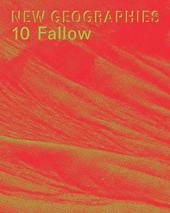
|
New Geographies 10: Fallow
Paperback / softback
Main Details
Description
The term fallow is borrowed from agriculture as a metaphor to critically examine the role of strategic dormancy in cycles of valorization and devalorization of the built and unbuilt environment. Rather than a strict binary of fecund or barren, however, New Geographies #10 conceives of fallowness as a rich and complex terrain to provoke a critical examination of the sites, strategies, scales, and imaginaries of the unused, the devalued, and the dormant, and explore modes of revalorization in all its forms: economic, ecological, social, cultural. Ultimately, it is hoped that this compilation will provide a foundation on which designers can build new lines of questioning regarding processes of urbanization that will illuminate new speculative horizons for the design disciplines, while also demarcating points for cross-disciplinary study of the built and unbuilt environments. Co-published with Harvard University Graduate School of Design.
Author Biography
Michael Chieffalo is a doctoral student, architect, and former planning commissioner. His current research engages with processes of agrarian urbanization; socio-environmental dimensions of factory farming; the diverse built environments of industrial agriculture; and the relation between geographies of industrial agriculture and processes of planetary urbanization. This bundled set of concerns is explored using historic and comparative analysis in service of critically analyzing how organizational rationales and spatial patterning of cities and zones of agricultural production evolve over time and in different political-economic contexts. He is finally interested in how human-animal relations have been understood, and species composition in cities been transformed, over time through the industrialization of livestock production. Julia Smachylo is an urban designer as well as a registered urban planner in Canada and the United Kingdom. Her research responds to an increased awareness and shift towards valuing natural capital in research and policy, as well as the growing influence of non-state actors such as environmental organizations, landowners, and the private sector in shaping landscapes in response to climate change. Using film as a method of investigation, her recent work focus on woodland areas in the province of Ontario, Canada, documenting incentivized managed forests to reveal the extent to which these landscapes are tied to the social, economic and political histories of production and conservation within the region.
|